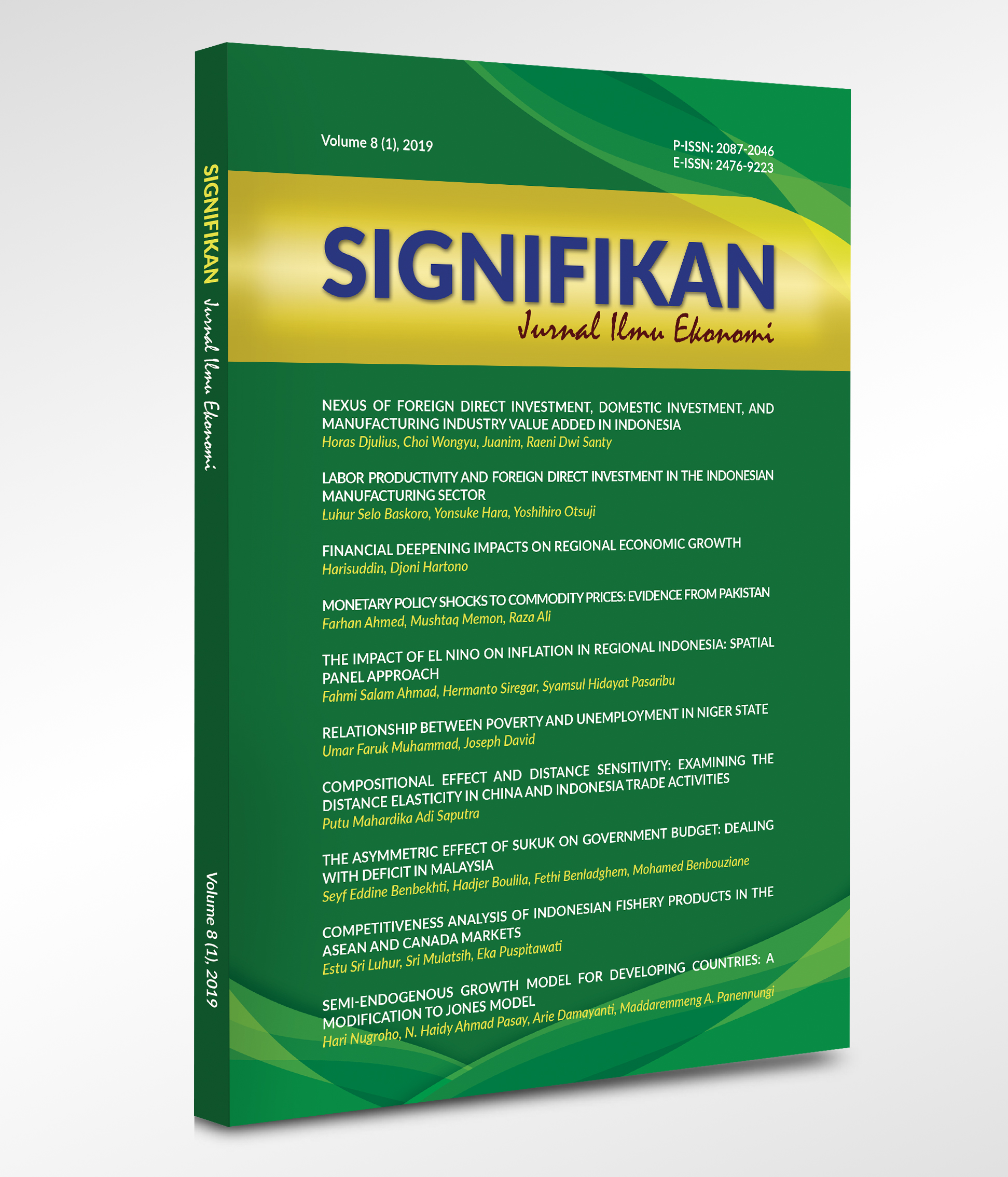Monetary Policy Shocks to Commodity Prices: Evidence from Pakistan
DOI:
https://doi.org/10.15408/sjie.v8i1.7012Keywords:
monetary policy, commodity prices, developing economy, vector auto-regression (VAR)Abstract
Monetary policy is always a dynamic attribute on commodity prices in the economy. This article examines the empirical relationship between monetary policy and commodity price by employing a vector auto-regression (VAR) Model to show its response in the case of Pakistan. In this paper, the research philosophy is employed based on Positivism with Deductive approach to recognizing the response of monetary policy shocks on commodity price. Recently, low-interest rates and excessive liquidity play a dynamic role in affecting the prices of the commodities market. Furthermore, the impact of monetary policy rate show significant result and seems to be huge in the economy of Pakistan massively. Besides, there is a stable relationship between monetary policy instrument and commodity prices even though the current financial crisis.
References
Ahmadi, M., Behmiri, N. B., & Manera, M. (2016). How is Volatility in Commodity Market Linked to Oil Price Shocks? Energy Economics, 59, 11–23. https://doi.org/10.1016/j.eneco.2016.07.006
Anzuini, A., Lombardi, M. J., & Pagano, P. (2013). The Impact of Monetary Policy Shocks on Commodity Prices. International Journal of Central Banking, 9(3), 125–150.
Belke, A., Bordon, I. G., & Hendricks, T. W. (2010). Global Liquidity and Commodity Prices–A Cointegrated VAR Approach for OECD Countries. Applied Financial Economics, 20(3), 227–242.
Bodenstein, M., Erceg, C. J., & Guerrieri, L. (2008). Optimal Monetary Policy with Distinct Core and Headline Inflation Rates. Journal of Monetary Economics, 55(S1), S18–S33.
Browne, F., & Cronin, D. (2010). Commodity Prices, Money and Inflation. Journal of Economics and Business, 62(4), 331–345.
Chambers, R. G., & Just, R. E. (1982). An Investigation of The Effect of Monetary Factors on Agriculture. Journal of Monetary Economics, 9(2), 235–247. https://doi.org/10.1016/0304-3932(82)90044-7
Cody, B. J., & Mills, L. O. (1991). The Role of Commodity Prices in Formulating Monetary Policy. The Review of Economics and Statistics, 73, 358–365.
Devereux, M. B., Lane, P. R., & Xu, J. (2006). Exchange Rates and Monetary Policy in Emerging Market Economies. The Economic Journal, 116(511), 478–506. https://doi.org/10.1111/j.1468-0297.2006.01089.x
Frankel, J. A. (2006). The Effect of Monetary Policy on Real Commodity Prices. Working Paper No. W12713. National Buerau of Economic Research.
Gali, J., & Monacelli, T. (2005). Monetary Policy and Exchange Rate Volatility in a Small Open Economy. The Review of Economic Studies, 72(3), 707–734.
Garner, C. A. (1985). Commodity Prices and Monetary Policy Reform. Economic Review, 70(2), 7–22.
Gelos, G., & Ustugova, Y. (2017). Inflation Responses to Commodity price shocks –How and Why do Countries Differ? Journal of International Money and Finance, 72, 28–47. https://doi.org/10.1016/j.jimonfin.2016.10.001
Gubler, M., & Hetweck, M. S. (2013). Commodity Price Shocks and the Business Cycle: Structural Evidence for the US. Journal of International Money and Finance, 37(324–352). https://doi.org/10.1016/j.jimonfin.2013.06.012
Hammoudeh, S., Nguyen, D. K., & Sousa, R. M. (2015). US Monetary Policy and Sectoral Commodity Prices. Journal of International Money and Finance, 57, 61–85. https://doi.org/10.1016/j.jimonfin.2015.06.003
Hove, S., Mama, A. T., & Tchana, F. T. (2015). Monetary Policy and Commodity Terms of Trade Shocks in Emerging Market Economies. Economic Modelling, 49, 53–71. https://doi.org/10.1016/j.econmod.2015.03.012
Lapp, J. S. (1990). Relative Agricultural Prices and Monetary Policy. American Journal of Agricultural Economics, 72(3), 622–630.
Laxton, D., & Pesenti, P. (2003). Monetary Rules for Small, Open, Emerging Economies. Journal of Monetary Economics, 50(5), 1109–1146.
Lovcha, Y., & Perez-Laborda, A. (2018). Monetary Policy Shocks, Inflation Persistence, and Long Memory. Journal of Macroeconomics, 55, 117–127. https://doi.org/10.1016/j.jmacro.2017.10.006
Pain, N., Koske, I., & Sollie, M. (2006). Globalisation and Inflation in the OECD Countries. OECD Economics Department Working Papers No. 524. https://doi.org/10.1787/377011785643
Parrado, E. A., Flippen, C. A., & McQuinston, C. (2004). Use of Commercial Sex Workers Among Hispanic Migrants in North Carolina: Implications for The Spread of HIV. Perspectives on Sexual and Reproductive Health, 36(4), 150–156.
Pindyck, R. S., & Rotemberg, J. J. (1993). The co-movement of stock prices. The Quarterly Journal of Economics, 108(4), 1073–1104.
Rafiq, S., & Bloch, H. (2016). Explaining Commodity Prices Through Asymmetric Oil Shocks: Evidence from Nonlinear Models. Resources Policy, 50, 34–48. https://doi.org/10.1016/j.resourpol. 2016.08.005
Scrimgeour, D. (2015). Commodity Price Responses to Monetary Policy Surprises. American Journal of Agricultural, 97(1), 88–102.
Tai, M. Y., Chao, C. C., Hu, S. W., Lai, C. C., & Wang, V. (2014). Monetary Policy and Price Dynamics in a Commodity Futures Market. International Review of Economics and Finance, 29, 372–379. https://doi.org/10.1016/j.iref.2013.06.007
Wang, Y., Wu, C., & Yang, L. (2014). Oil Price Shocks and Agricultural Commodity Prices. Energy Economics, 44, 22–35. https://doi.org/10.1016/j.eneco.2014.03.016
Wynne, M. A., & Kersting, E. K. (2007). Openness and Inflation. Working Paper Federal Reserve Bank of Dallas.

